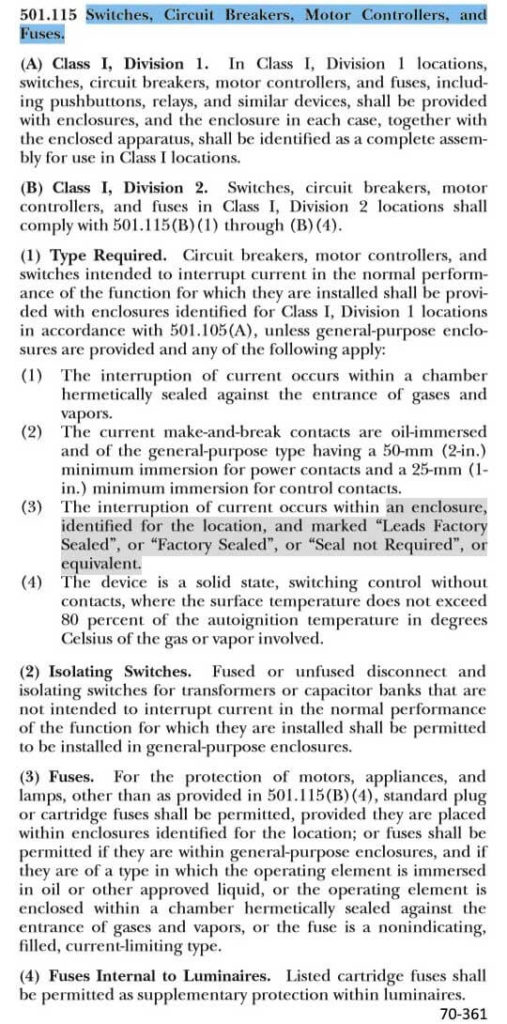Nec Article 501
The National Electrical Code (NEC) is a standard for the safe installation of electrical wiring and equipment in the United States. In particular, Article 501 outlines the standards for Class I Hazardous Locations. While it may not be the most exciting topic, knowing and following these regulations can prevent dangerous and costly accidents.
Pain Points
Without proper precautions, hazardous locations can quickly become a safety hazard for workers and passersby. Explosions, fires, and other dangers can occur if electrical equipment isn't designed, installed, and maintained correctly. These accidents can lead to injury, property damage, and even loss of life. Plus, noncompliance with the NEC can result in costly fines and legal fees.
Target of NEC Article 501
NEC Article 501 outlines the requirements for the installation and use of electrical equipment in locations where there is a potential for explosive gases or vapors. In other words, this article sets the standards for safe electrical practices in areas where flammable materials are present. This includes locations such as gasoline storage areas, paint booths, and chemical processing plants.
Main Points and Keywords
NEC Article 501 requires that electrical equipment be designed and installed in a way that prevents ignition of flammable substances. This includes using explosion-proof equipment, limiting the amount of electrical energy in the area, and properly grounding and bonding all equipment. Any equipment in these hazardous locations must also be properly labeled and tested for use in that environment. Following NEC Article 501 can save lives, prevent damage, and keep you out of legal trouble.
Personal Experience
During my time working at a chemical plant, I witnessed firsthand the importance of complying with NEC Article 501. One day, a small spark caused a massive explosion in one of the processing areas. Fortunately, nobody was seriously hurt, but the damage to the equipment and surrounding area was significant. After an investigation, it was discovered that the explosion was caused by the ignition of flammable gases due to a lack of proper electrical equipment and maintenance. Since then, I have always made sure to follow the NEC regulations and encourage my coworkers to do the same.

Stay Safe with NEC Article 501
Complying with NEC Article 501 can feel overwhelming, but it's essential for your safety and the safety of those around you. Take the time to research and understand the regulations that apply to your work environment. Don't be afraid to ask questions or request training on safe electrical practices. By doing so, you can help prevent dangerous accidents and save lives.
Explosive Gasoline Locations
NEC Article 501 specifies the requirements for electrical equipment in Class I locations with explosive gases or vapors present. For example, gasoline storage areas are a prime example of a Class I Hazardous Location. Equipment in these locations must be specifically designed, tested, and labeled for use in such an environment.

Proper Testing and Labeling
One critical aspect of NEC Article 501 is the requirement for proper testing and labeling of electrical equipment. All equipment in hazardous locations must be specifically tested and approved for use in that environment. This includes explosion-proof designs, protective enclosures, and the ability to withstand the specific hazards present. Additionally, all equipment must be properly labeled with the appropriate certification and warnings.

Question and Answer
Q: Are there any exceptions to following NEC Article 501?
A: While there are some exceptions to the NEC regulations, they are few and far between. It's best to assume that these regulations apply to your work environment and follow them to ensure everyone's safety.
Q: Who is responsible for ensuring compliance with NEC Article 501?
A: Ultimately, it's the responsibility of the employer to ensure that their workplace meets the NEC standards. However, employees and contractors also have a responsibility to follow safe electrical practices and report any potential hazards to their supervisors.
Q: What are the penalties for noncompliance with NEC Article 501?
A: Depending on the situation, noncompliance with NEC Article 501 can result in fines, legal fees, and even criminal charges. Additionally, accidents resulting from noncompliance can lead to injury, property damage, and even loss of life.
Q: How often should electrical equipment in hazardous locations be inspected?
A: Electrical equipment in hazardous locations must be inspected, tested, and maintained regularly to ensure that it's safe for use in that environment. The frequency of these inspections will vary depending on the type of equipment and the specific hazards present. Always refer to the NEC regulations and local codes for guidance.
Conclusion of NEC Article 501
Staying safe in hazardous locations requires following strict regulations and taking the proper precautions. The NEC's Article 501 sets the standards for safe electrical practices in Class I Hazardous Locations. By complying with these regulations, you can protect yourself, your coworkers, and the environment from dangerous accidents and potential legal trouble.
Gallery
NEC Article 501: Class I Hazardous Locations | EC&M

Photo Credit by: bing.com / nec hazardous brutlag
NEC Article 501: Class I Hazardous Locations | EC&M

Photo Credit by: bing.com / nec hazardous ecmweb
NEC Article 501: Class I Hazardous Locations | EC&M

Photo Credit by: bing.com / nec hazardous ecmweb refinery edmonton petro alberta
2017 NEC Article 501.115 - Thompson Learning - Home Of Electrical

Photo Credit by: bing.com / nec codebook snippet
NEC Article 501: Class I Hazardous Locations | EC&M

Photo Credit by: bing.com / nec hazardous ecmweb albuquerque summit helps
0 Response to "Nec Article 501"
Posting Komentar